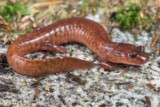Stream salamander population ecology and evolution
Project Overview:

Photo by Ryan Wagner
Our research uses data from long term studies of a stream salamander, the spring salamander (Gyrinophilus porphyriticus), to answer basic questions in population ecology and evolution. By surveying streams throughout the summer field season and across years, we track the survival, movement, physical attributes, and genetic characteristics of salamanders over time. With those data, we are able to link environmental conditions to changes in individual traits, population dynamics, and patterns of genetic variation throughout the Hubbard Brook Experimental Forest. Our recent studies focus on why some individuals disperse far from their place of origin, how climate-related changes in streamflow are affecting species that live in streams, and whether metamorphosis – when salamanders transform from aquatic larvae to adults that can live on land – makes species more or less vulnerable to environmental change.
Lowe, W.H., T.E. Martin, D.K. Skelly, and H.A. Woods. 2021. Metamorphosis in an era of increasing climate variability. Trends in Ecology & Evolution 36:360-375. Addis, B.R., and W.H. Lowe. 2020. Long-term survival probability, not current habitat quality, predicts dispersal distance in a stream salamander. Ecology 101:e02982.
Lowe, W.H., L.K. Swartz, B.R. Addis, and G.E. Likens. 2019. Hydrologic variability contributes to reduced survival through metamorphosis in a stream salamander. Proceedings of the National Academy of Sciences (USA) 116:19563-19570. Lowe, W.H. and B.R. Addis. 2019. Matching habitat choice and plasticity contribute to phenotype-environment covariation in a stream salamander. Ecology https://doi.org/100:e02661.
Addis, B. (2019). Causes of variation in dispersal distance in the stream salamander Gyrinophilus porphyriticus [PhD Thesis]. University of Montana.
Addis, B. R., & Lowe, W. H. (2020). Long-term survival probability, not current habitat quality, predicts dispersal distance in a stream salamander. Ecology, 101(4), e02982. https://doi.org/10.1002/ecy.2982
Bayer, M. O., & Lowe, W. H. (2021). Top-Down Effects of Salamanders on Macroinvertebrates in Fishless Headwater Streams. Herpetologica, 77(2), 111–120. https://doi.org/10.1655/Herpetologica-D-20-00054.1
Davenport, J. M., & Lowe, W. H. (2015). Does dispersal influence the strength of intraspecific competition in a stream salamander? Journal of Zoology, n/a-n/a. https://doi.org/10.1111/jzo.12282
Davenport, J. M., & Lowe, W. H. (2016). Does dispersal influence the strength of intraspecific competition in a stream salamander? Journal of Zoology, 298(1), 46–53. https://doi.org/10.1111/jzo.12282
Deitchler, E., M., J. M. D., & H., W. L. (2015). Homing behavior of the northern spring salamander Gyrinophilus porphyriticus, in a northeren United States headwater stream. Herpetological Conservation and Biology, 10(1), 235–241.
Lowe, W. H., & Addis, B. R. (2019). Matching habitat choice and plasticity contribute to phenotype–environment covariation in a stream salamander. Ecology, 100(5), e02661. https://doi.org/10.1002/ecy.2661
Lowe, W. H., Addis, B. R., Smith, M. R., & Davenport, J. M. (2018). The spatial structure of variation in salamander survival, body condition and morphology in a headwater stream network. Freshwater Biology, 63(10), 1287–1299. https://doi.org/10.1111/fwb.13133
Current Projects
We combine long-term monitoring with visionary experiments to advance our understanding of forest ecology.
